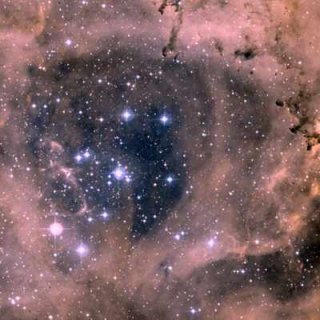
 |
The Rosette Nebula, just to the east of Epsilon Mon and one of the most famed of diffuse nebulae, is illuminated (ionized) by hot stars within a whole young cluster at its hollowed-out center. The inner portion is seen here. Note the contrast between the hot blue stars and the red color of the nebula, which is caused by emission from hydrogen. Similar to the Orion Nebula, but much bigger, at a distance of around 5400 light years, it's over 50 light years across. Buried within, and in the foreground, are long black streamers and clouds of dusty interstellar gas that are associated with new star formation. [NASA, the DSS-II and GSC-II Consortia (with images from the Palomar Observatory-STScI Digital Sky Survey of the northern sky, based on scans of the Second Palomar Sky Survey copyright 1993-1999 by the California Institute of Technology.)] |